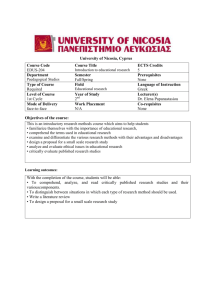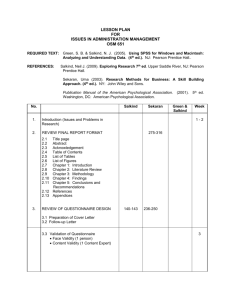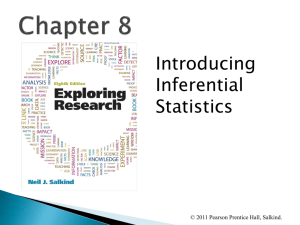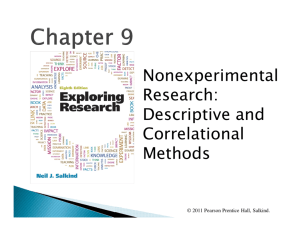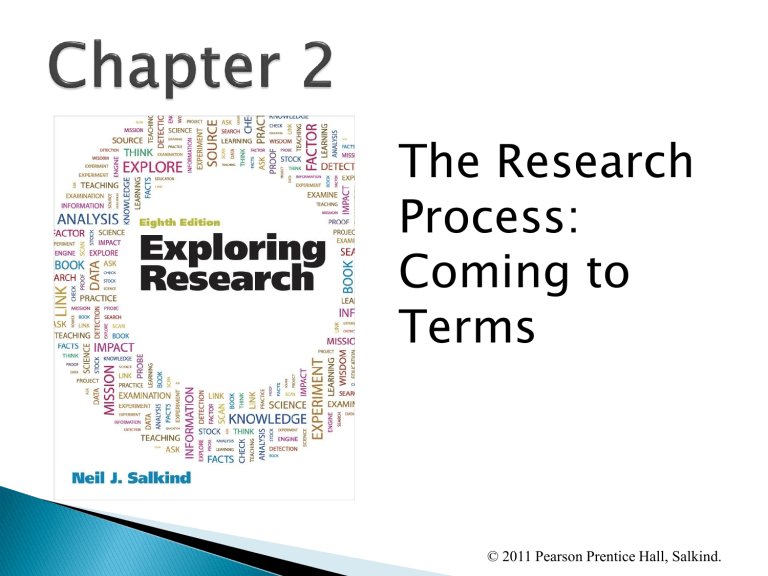
The Research
Process:
Coming to
Terms
© 2011 Pearson Prentice Hall, Salkind.
Describe the research process from formulating
questions to seeking and finding solutions.
Describe the difference between dependent and
independent variables.
Identify other types of variables that may
interfere with the research process.
Define a hypothesis and describe how it works.
Discuss the value of the null hypothesis.
© 2011 Pearson Prentice Hall, Salkind.
Describe the differences between a null
hypothesis and a research hypothesis.
List the characteristics of a good hypothesis.
Explain the difference between a sample and
the population.
Define statistical significance and explain its
importance.
© 2011 Pearson Prentice Hall, Salkind.
From Problem to Solution
All About Variables
Other Important Types of Variables
Hypotheses
Samples and Populations
The Concept of Significance
© 2011 Pearson Prentice Hall, Salkind.
© 2011 Pearson Prentice Hall, Salkind.
Increasing our understanding of how and why
we behave the way we do!!
© 2011 Pearson Prentice Hall, Salkind.
From Problem to Solution
◦ Noting an interesting question
◦ Stating the question in such a way that it can be
answered
The Language of Research
© 2011 Pearson Prentice Hall, Salkind.
© 2011 Pearson Prentice Hall, Salkind.
Variables are a class of outcomes that can
take on more than one value
The more precisely a variable is measured,
the more useful the measurement is
© 2011 Pearson Prentice Hall, Salkind.
The outcomes of a research study
Depend on the experimental treatment
© 2011 Pearson Prentice Hall, Salkind.
Treatments or conditions under control of the
researcher
Levels—at least two different values of the
independent variable must be present
© 2011 Pearson Prentice Hall, Salkind.
© 2011 Pearson Prentice Hall, Salkind.
Independent variable is not confounded
◦ Levels do not vary systematically with other
variables
Dependent variable is sensitive to changes
in the independent variable
© 2011 Pearson Prentice Hall, Salkind.
© 2011 Pearson Prentice Hall, Salkind.
Control Variable: Has a potential influence on
the dependent variable
Extraneous Variable: Has an unpredictable
impact on the dependent variable
Moderator Variable: Variables related to
independent or dependent variables, and
hiding the true relationship between
independent and dependent variables
© 2011 Pearson Prentice Hall, Salkind.
Type of
Variable
Dependent
Definition
Other Terms
You Might See
A variable that is measured to see whether the
treatment or manipulation of the independent
variable had an effect
Independent
A variable that is manipulated to examine its impact
on a dependent variable
Control
A variable that is related to the dependent variable,
the influence of which needs to be removed
Extraneous
A variable that is related to the dependent variable
or independent variable that is not part of the
experiment
Moderator
A variable that is related to the dependent variable
or independent variable and has an impact on the
dependent variable
Outcome variable
Results variable
Criterion variable
Treatment
Factor
Predictor variable
Restricting
variable
Threatening
variable
Interacting
variable
© 2011 Pearson Prentice Hall, Salkind.
© 2011 Pearson Prentice Hall, Salkind.
Reflects the general problem under study
Restates the general problem in a form that is
precise enough to allow testing
© 2011 Pearson Prentice Hall, Salkind.
States that there is no relationship between the
independent and dependent variables under
study
Ho: µ1 = µ2
◦ Ho: Null hypothesis
◦ µ1: Theoretical average of population 1
◦ µ2: Theoretical average of population 2
© 2011 Pearson Prentice Hall, Salkind.
A starting point for analysis
◦ Accepted as true absent other information
◦ Assumes that chance caused any observed
differences
Provides a benchmark for comparison
© 2011 Pearson Prentice Hall, Salkind.
A statement of inequality
A relationship exists between the
independent and dependent variables
• H1: X1 ≠ X2
– H1: Research hypothesis
– X1: Theoretical average of population 1
– X2: Theoretical average of population 2
© 2011 Pearson Prentice Hall, Salkind.
Nondirectional Research Hypothesis
◦ Groups are different, but direction is not specified
◦ H1:
X1
≠
X2
Directional Research Hypothesis
◦ Groups are different, and direction is specified
◦ H1:
◦ H1:
>
X1 X2
<
X1 X2
© 2011 Pearson Prentice Hall, Salkind.
Directly tested during research process
To compare against null hypothesis
© 2011 Pearson Prentice Hall, Salkind.
Null
◦ Equality between
variables
◦ Refers to population
◦ Indirectly tested
◦ Stated using Greek
symbols (µ)
◦ Implied
Research
◦ Inequality between
variables
◦ Refers to sample
◦ Directly tested
◦ Stated using Roman
symbols ( )
X
◦ Explicit
© 2011 Pearson Prentice Hall, Salkind.
Is stated in declarative form
Posits a relationship between variables
Reflects theory or literature
Is brief and to the point
Is testable
© 2011 Pearson Prentice Hall, Salkind.
© 2011 Pearson Prentice Hall, Salkind.
The SAMPLE is a representative portion of a
POPULATION
The POPULATION is the entire group of
interest
Results from the SAMPLE should generalize to
the POPULATION
© 2011 Pearson Prentice Hall, Salkind.
© 2011 Pearson Prentice Hall, Salkind.
Observed differences (PROBABLY) result from
the treatment and not from chance
Why?
◦ Influences other than the treatment
Significance level = risk associated with not
being 100% certain that null hypothesis is
incorrect
© 2011 Pearson Prentice Hall, Salkind.
Describe the research process from formulating
questions to seeking and finding solutions?
Describe the difference between dependent and
independent variables?
Identify other types of variables that may
interfere with the research process?
Define a hypothesis and describe how it works?
Discuss the value of the null hypothesis?
© 2011 Pearson Prentice Hall, Salkind.
Describe the differences between a null
hypothesis and a research hypothesis?
List the characteristics of a good hypothesis?
Explain the difference between a sample and
the population?
Define statistical significance and explain its
importance?
© 2011 Pearson Prentice Hall, Salkind.

